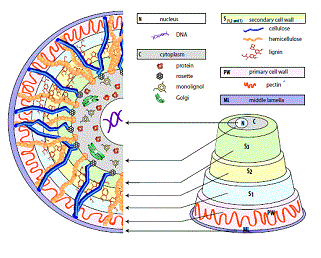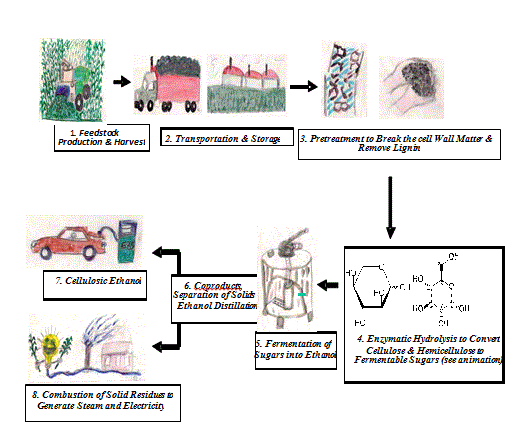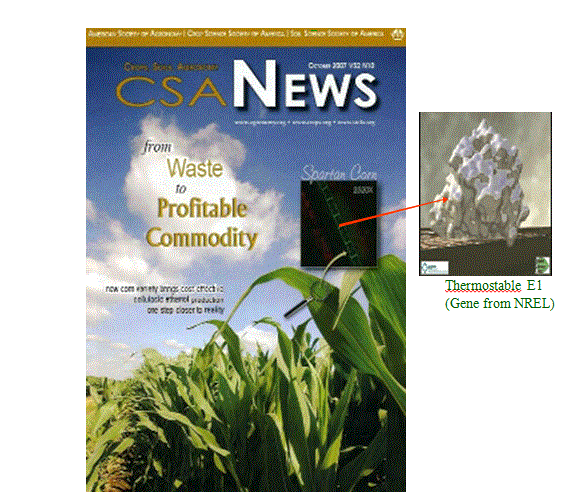Review Article Open Access
Towards Cellulosic Biofuels Evolution: Using the Petro-Industry Model
| Mariam B Sticklen1*, Hussien F Alameldin1 and Hesham F Oraby2 | ||
| 1Department of Crop and Soil Sciences, Michigan State University, East Lansing, MI, USA | ||
| 2Cellulosic Biofuel Network, Agriculture and Agri-Food Canada, Québec, Québec, Canada; and Faculty of Agriculture, Zagazig University, Egypt | ||
| Corresponding Author : | Mariam B Sticklen Department of Crop and Soil Sciences Michigan State University, East Lansing, MI, USA Tel: 517-230-2929 E-mail: Stickle1@msu.edu |
|
| Received August 20, 2013; Accepted May 29, 2014; Published May 31, 2014 | ||
| Citation: Sticklen MB, Alameldin HF, Oraby HF (2014) Towards Cellulosic Biofuels Evolution: Using the Petro-Industry Model. Adv Crop Sci Tech 2:131. doi: 10.4172/2329-8863.1000131 | ||
| Copyright: © 2014 Sticklen MB, et al. This is an open-access article distributed under the terms of the Creative Commons Attribution License, which permits unrestricted use, distribution, and reproduction in any medium, provided the original author and source are credited. | ||
Related article at Pubmed Pubmed  Scholar Google Scholar Google |
||
Visit for more related articles at Advances in Crop Science and Technology
Abstract
While the United States owns only three percent (3%) of the total world petro-oil reserves, it uses over twenty-five percent (25%) of its total global output on an annual basis. Furthermore, the US petro-oil consumption is expected to double by 2050. While the sources for US oil are innumerable, many of the countries which contribute vastly to the US oil supply are economically and politically unstable. This has led to concerns about the security of the US oil supply, since a major political disturbance could be devastating. This article describes a model for the production of affordable and renewable biofuels as well as recombinant high-value industrial co-products from crop residues—waste products in today’s farming environment without competition between commodities critical to global food and feed supplies. This model represents a uniquely attractive business case giving the environmental and economic advantage it would have over petro-oil derived fuels and byproducts. Moreover, it can assist the developed nations to reduce their dependence on imported petro-oil fuels as well as improves the lives of agriculture producers in developed and developing nations around the globe.
| Abstract |
| While the United States owns only three percent (3%) of the total world petro-oil reserves, it uses over twenty-five percent (25%) of its total global output on an annual basis. Furthermore, the US petro-oil consumption is expected to double by 2050. While the sources for US oil are innumerable, many of the countries which contribute vastly to the US oil supply are economically and politically unstable. This has led to concerns about the security of the US oil supply, since a major political disturbance could be devastating. This article describes a model for the production of affordable and renewable biofuels as well as recombinant high-value industrial co-products from crop residues—waste products in today’s farming environment without competition between commodities critical to global food and feed supplies. This model represents a uniquely attractive business case giving the environmental and economic advantage it would have over petro-oil derived fuels and byproducts. Moreover, it can assist the developed nations to reduce their dependence on imported petro-oil fuels as well as improves the lives of agriculture producers in developed and developing nations around the globe. |
| Keyword |
| Cellulosic biofuels; Ethanol; Bioenrgy crops; Cellulose; Enzymatic hydrolysis; Recombinant co-product; Biopharmaceuticals; Petro-industry |
| The Petro-Industry Model |
| Major technology developments normally follow a microevolution that at least lasts for half a century before becoming mature and profitable. Sometimes, major technologies merge to synergistically promote an industrial revolution. For example, Henry Ford, with his discovery of the internal combustion engine, would have never become the father of auto-industry without the petro-oil revolution [1]. Moreover, the success and importance of the petrochemical industry to the US economy is clearly confirmed. While close to 60 percent of the crude oil used in the US is imported– about 95 percent of the refined petroleum products and about 80 percent of the petrochemicals are manufactured domestically [2]. Therefore in the petro-industry model, the revenue is acquired from petroleum fuels as well as their co-products. For example, one barrel of oil contains 46% gasoline, 9% jet fuel, 26% diesel and 19% petrochemical products [3]. The value of these chemical products is about the same as the value of transportation fuel which give the great economic impact of these industrial petrochemicals [4]. Nevertheless, this chemical industry is currently reliant on an inexpensive petroleum-based carbon feedstock from which a compilation of a large variety of chemical products can be manufactured [4]. The non-sustainability of petro-oil and petrochemical feedstocks that require millions of years to form has created the forward motion to explore alternative renewable sources of carbon and have shaped the new biofuel revolution to supplement the petro-oil usage. |
| The First Generation or Food-Based Biofuels |
| The first generation biofuels are food-based. They consist of ethanol produced from starch of grains and sugars of sugar crops, and biodiesel produced from vegetable oils. |
| The idea of ethanol production came in 1925 when Henry Ford was quoted from his interview by a New York Times reporter “There is fuel in every bit of vegetable matter that can be fermented [5].” Few years after, the Coryell Gas Company began selling a 10 percent blend of "Corn Alcohol" gasoline in Lincoln, Nebraska, in 1933 (Figure 1). |
| Approximately 40% of the world’s ethanol production uses grain crops (corn, wheat, sorghum and barley) as the primary feedstock while the other 60% uses sugarcane [6]. Although world ethanol and biodiesel production provides about 1.8% of the world’s fuel supply, the competition between the use of agricultural products for fuels or for feeding the hunger has received considerable debate [7,8]. In the 2006 to 2008 time-frame, the need for grains for food and feed rocketed world corn and wheat prices and in some cases created food riots in many countries around the globe [9]. Sugar-based ethanol has not affected sugar prices significantly only because that the rapid production in Brazil to meet the demands averted the supply-demand conflict. However, red flags have been prominently raised to warn of the impact of sugar cane cultivation expansion on biodiversity hotspots and on depleting cattle ranches affecting meat production industries [10]. On the global level, anxiety has sparked again with the publication of the United Nations’ latest food price indices that demonstrated a twenty-three percent (23%) increase in agricultural commodity prices in 2010 [11]. Therefore, food-based ethanol is no more of a long-term solution to the transportation fuel needs of the world; rather, it represents a great transitional technology. |
| The Second Generation or Cellulosic Biofuels |
| The second generation or cellulosic biofuels are produced through the conversion of lignocellulosic matter from bioenergy crops into alcohol fuels such as butanol and ethanol which will be the main focus of this review. |
| In 2008, a few commercial scale cellulosic ethanol production plants were established in the U.S.; which they currently produce 12 million liters per year of cellulosic ethanol, with a total capacity of another 80 million liters per year. Several other cellulosic ethanol plants were established in other countries including Canada and a few European countries. The Canadian plants recently reported a capacity of 6 million liters per year and those in Europe, a capacity of 10 million liters per year [12]. |
| Cellulosic Bioenergy Crops |
| Crop species that meet the standard requirements of a good cellulosic bioenergy feedstock with low life-cycle greenhouse-gas emission and no competition with food production include: (1) crops with after-harvest residues such as corn stover, grass hay, wheat, barley, oats, rice and triticale straw; (2) C4 crops that exhibit high biomass yield, high energy output-to-input ratio, very efficient photosynthetic capacity and lower greenhouse gas emissions as well as suitability for possible cropping in marginal lands (for example; sugar cane, energy cane, sorghum, elephant grass, switchgrass and miscanthus); (3) C3 perennial forages that have low reliance on fertilizers and pesticides, high carbon sequestration, low energy input requirements and high net energy yield such as reed canary grass, and alfalfa that can be used as a dual purpose high revenue crop by fractionating it into stems for energy production and leaves as feed protein co-product; and, (4) fast growing short rotation tree species with high salinity tolerance, wide geographical distribution and good wildlife habitat such as poplars, willows and eucalyptus. |
| Plant Cell Wall Lignocellulosic Matter |
| Plant cell wall structures (Figure 2) are deposited outside the cellular cytoplasm. The main roles of the plant cell walls are to provide strength, protect plants against winds and other physical forces and prevent water evaporation from cells for the retention of optimal cellular osmotic pressure. The composition of cell walls varies depending on plant species, tissue type, cell type, region within the cell wall and developmental stage of the cell. Plant cells contain two major cell walls, the primary wall (i.e. semi-permeable wall allowing intercellular transfer of carbon dioxide, water, nutrients and other small molecules), and the secondary wall (i.e. water resistant wall) along with a small layer called middle lamella. The secondary wall in certain tissues such as xylem contains three layers called S1, S2 and S3 (Figure 2). Both primary and secondary cell walls contain cellulose and hemicelluloses. Primary walls also contain pectins as well as many structural proteins and enzymes including peroxidases, esterases, transglycosylases and hydrolases that cross-link other cell wall components, whereas secondary walls contain little protein or pectin, but normally contain lignin [13]. During secondary wall biosynthesis, the primary wall also becomes impregnated with lignin [14]. This impregnation with lignin provides rigidity and structural support as well as makes them hydrophobic and more resistant against the attacks of microorganisms [13]. |
| Cell wall cellulose is made of cascades of microfibrils-containing glucose molecules that are connected via inter- and intra-molecular hydrogen bonds. Most regions of the cellulose microfibrils are in crystalline form and some are amorphous. |
| Hemicellulose is a complex branched carbohydrate polymer that are formed from different monomeric sugars attached through different linkages. Sugar monomers in the hemicellulose include xylose, mannose, galactose, rhamnose, and arabinose. Hemicellulose contains most of the D-pentose sugars, and occasionally small amounts of L-sugars as well. |
| Pectin is primarily made of polymers of β 1,4 galacturonans or homogalacturons, which are cross-linked by diferulic acids or dihydrocinnamic. Cell wall pectin is mostly composed of rhamnose and galacturonic acid. |
| Lignin arises from coupling reactions of three monolignols precursor alcohols, p-coumaryl, coniferyl and sinapyl. Its composition is generally characterized by the relative abundance of p-hydroxyphenyl (H), guaiacyl (G) and syringyl (S) units and by the distribution of interunit linkages in the polymer [15]. |
| Plant lignocellulosic matter is referred to the cell wall biomass mostly containing lignin, cellulose and hemicellulose (Figure 2). |
| Cellulosic Ethanol Production Pathway |
| Steps associated with ethanol production from lignocellulosic matter are illustrated in Figure 3. These steps include: (1) production, transportation, washing, chopping or grinding of feedstock crops; (2) transportation and storage of the biomass; (3) physical, chemical, electrical and/or biological pretreatment of biomass breakdown, removing lignin and preparing it to enzymatic hydrolysis; (4) digesting the pretreated feedstock with a mixture of three classes of microbial enzymes; endo- and exo-cellulases that synergistically breakdown the cellulose into cellobiose (see animation: https://www.msu.edu/~stickle1/Cellulase_Animation.wmv) and microbial cellobiases that digest the cellobiose into glucose, which also relieve the cellobiose-induced inhibition of cellulases; (5) microbial fragmentation of the feedstock and fermentation of six-carbon and five-carbon sugars into ethanol solution and solid residues; (6) physically separating the ethanol solution from the solid residues; (7) cellulosic ethanol recovery via distillation and removal of water; and production of relatively high volume co-products [16,17] such as succinic acid, lactic acid, acetic acid, glycerol, nano-fibers and plywood adhesive from the solid residues; and (8) combustion of the left-over solid residues in boilers to generate steam and electricity for the biorefinary. |
| Model for Affordable Cellulosic Biofuels |
| The Cellulosic Biofuels Summit of 2010 reported that “the cellulosic biofuels industry has reached a critical stage in its history and must figure out how to obtain the financing it needs to enable the industry to survive and thrive.” The summit referred to the path forward for cellulosic biofuels as a puzzle requiring innovations because, despite government subsidies, federal loans and other financial aids, the cost of commercial production of cellulosic ethanol is still prohibitively high, and all the lignocellulosic plants are either grown specifically for demonstration or are heavily subsidized by governments [18]. |
| Therefore, the cellulosic bio refineries economics should dependent on not only ethanol but also the production of co-products such as proteins, chemicals and polymers to provide revenue streams to counterbalance processing costs allowing cellulosic ethanol to be sold at lower prices. Furthermore, generation of the co-products results in greater biomass and land use efficiencies along with a more effective use of invested capitals. These days, technological innovations are focusing on utilizing every fraction of the biomass feedstock especially the by-products from one process to become the raw materials for another product. |
| The most expensive step in the conversion of lignocellulosic feedstock into fermentable sugars is the pretreatment of lignocellulosic matter. Depending on the method used, costs associated with pretreatment were approximately $1.00 to $2.15 per gallon of ethanol few years ago [19]. Tremendous efforts have concentrated upon the improvement of pretreatment processes to lower the costs and improve the breakdown of lignocellulosic efficiency [20]. One method being followed is to add ligninase enzymes to the ground lignocellulosic feedstock to help with lignin degradation. Since production of ligninases in microbial fementers is still very expensive, producing the ligninases within the crop biomass via genetic modification is to reduce the need for the pretreatment process [21]. |
| Another method is to genetically modify bioenergy crops for changes in lignin structure and/or quantity while keeping the transgenic plants healthy and non-susceptible to insects and pathogens. In fact this method not only reduces the pretreatment costs but also in certain cases provides an energy shift from lignin to cellulose and/or hemicellulose biosynthesis. For example, a decrease in the lignin biosynthesis enzyme cinnamoyl CoA reductase in corn (ZmCCR) via the RNAi technology caused a reduction in lignin content by approximately 7-9% and two fold increase in crystalline cellulose in some independent transgenic events (Figure 4). Furthermore, a recent report indicates that down regulation of caffeic acid 3-O-methyltransferase (COMT), another lignin biosynthesis enzyme, in switchgrass caused lignin reduction by approximately 10% and increased cellulosic ethanol production by 38% using conventional biomass fermentation processes [22]. |
| The lignin residue from the hydrolysis process, while a small fraction, has as energy content as in coal and can be employed to power the operation, thereby reducing production costs. |
| In the same context, the process of microbial cellulases bulk production needed for the enzymatic hydrolysis of the pretreated matter is expensive [24]. The production of microbial cellulase mix costs approximately between $0.35 [25] and $1 per gallon of ethanol [26]. It is assumed that the cellulosic biofuels industry could reduce this cost by either two fold increase in the kinetic activity of the enzymes during hydrolysis [27] or by expressing the related microbial genes directly into bioenergy crops (Figure 5) via genetic engineering [1,28]. Hence, it could be possible to use half or less of the required amounts of these enzymes. For example, a recent techno economic analysis of lignocellulosic bio refineries showed that by using enzymes with increased cellulolytic activity, a saving of $0.47 per gallon of ethanol could be achieved [25]. |
| In another economic analysis performed to examine the production of Acidothermus cellulolyticus endocellulase (E1) in rice straw, the total revenue of $9.64 per kg of enzyme ($21.2/acre) was feasible. Recently, successful production of a set of hydrolysis heterologous enzyme cocktails in tobacco chloroplast [29] and in different compartments in corn stover [30] was achieved. In the case of corn stover, Acidothermus cellulolyticus endocellulase and Trichoderma reesei 1,4-β-cellobiohydrolase I were estimated to be 400 and 622 grams per ton of dry Stover and 752 and 1165 grams per ton of wet silage respectively [30]. |
| It is recommended to use crude protein containing heterologous cellulases instead of the purified heterologous cellulases for enzymatic hydrolysis of crop biomass. The plant crude proteins would not only eliminate cellulose purification costs, but also it contains other valuable molecules such as cell wall loosening enzymes that break microfibril cellulose hydrogen bonds or bonds between cellulose and other cell wall polysaccharides resulting in ease in cell wall degradation [31]. |
| In addition, an array of higher value recombinant co-products can be produced within bioenergy crops such as biopharmaceuticals [33] such as interleukin-2 or IL-2 (Figure 6), spider silk, collagen, novel carbohydrates [34], biodegradable plastic [35] and other biopolymers [36]. These proteins along with bioenergy crop conventional co-products such as lactic and succinic acid can strongly improve the cellulosic biofuels revenue generation, and contribute to sustainable clean environment and agricultural development. |
| It is worth to mention that, more research is needed to ensure that proteins and lignocellulosic converting enzymes produced within plants will survive harvest, storage, transportation and extraction [37]. |
| A yet new area of research is to produce high percentage of biodiesel oil in non-edible tissues of crops naturally have abundant leaves [39] through oil metabolic engineering of those crops. The oil produced in crop vegetative wastes can be relatively cheaply extracted without any needs for pretreatment processes. However, the question to be raised is whether oil in crop vegetative wastes residues that are somehow not removed from the farm has a negative effect on soil microbial population. |
| Conclusions |
| Affordability is the key factor preventing the effective commercialization of cellulosic biofuels. Following an advanced version of the petro-industry model, biotechnology for the production of high value recombinant co-products in bioenergy crops coupled with the development and use of lignin-down regulated bioenergy crops are expected to bring higher revenues and expedite the commercialization of the cellulosic biofuels agenda [26]. Affordable cellulosic biofuels and high value co-products have a societal advantage over petro-oil derived fuels and byproducts. Cellulosic biofuels are environmentally friendly and allow agriculture producers throughout the developed and developing nations around the globe to share in the bioenergy revolution. A following link is for a short video describing steps associated with the role of biotechnology in the production of biofuels and recombinant co-products (http://www.youtube.com/watch?v=Td9C_EnWXn8). All said, scientists, industries, and governments must use safe methodologies associated with the production of genetically engineered bioenergy crops and examine potential side effects and consequences of utilizing such recombinant crops in order to reduce potential risks [40,41]. |
| Acknowledgement |
| The authors acknowledge the Consortium for Plant Biotechnology Research (CPBR) and Michigan Corn Marketing Program (CMPM) for their financial supports resulting in Figures 4-6. |
| References |
References
|
Figures at a glance
 |
 |
 |
 |
 |
 |
|||||
| Figure 1 | Figure 2 | Figure 3 | Figure 4 | Figure 5 | Figure 6 |
Relevant Topics
- Agricultural science
- Agronomy
- Climate impact on crops
- Crop Productivity
- Crop Sciences
- Crop Technology
- Field Crops Research
- Hybrid Seed Technology
- Irrigation Technology
- Organic Cover Crops
- Organic Crops
- Pest Management
- Plant Genetics
- Plant Breeding
- Plant Nutrition
- Seed Production
- Seed Science and Technology
- Soil Fertility
- Weed Control
Recommended Journals
Article Tools
Article Usage
- Total views: 14870
- [From(publication date):
August-2014 - Apr 02, 2025] - Breakdown by view type
- HTML page views : 10215
- PDF downloads : 4655
